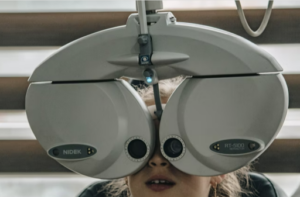Visual Agnosia: What It Is, Causes, Symptoms & Treatment
What is visual agnosia?
Visual agnosia is a neurological disorder affecting your ability to solely use your sense of sight to identify everyday items or people. Instead, you have to use other senses to identify everyday items. This condition affects your ability to identify familiar objects using one of your five senses. The word agnosia derives from a Greek word alluding to a “lack of knowledge.”For instance, you would only be able to name a pear by smelling, tasting or touching it. Simply looking at a pear would not help you identify the fruit.

This happens because one of two main visual pathways in the brain is damaged. The first pathway, otherwise known as the “what” pathway, alludes to what you are seeing. The second pathway, or the “where” pathway, is linked to an object’s location. [1]
You may not have other problems with your vision or with their memory. Yet if you are suffering from this eye disease, you probably have some parts of the cerebral cortex (in charge of processing certain aspects of vision) adversely affected.
What are the symptoms of visual agnosia?
The symptoms vary based on the type of agnosias.
If you have general visual agnosia, you cannot identify familiar objects by sight. Apperceptive visual agnosia and associative visual agnosia are two primary kinds of general visual agnosia.
It happens when you find it challenging to identify images your eyes see. According to how severe your apperceptive visual agnosia is, you may be unable to:
- Recognise the form or size of an object
- Differentiate between objects
- Draw common objects based on reality
You may also experience challengings associating an object with memories of similar objects. That being said, you may be able to draw or verbally describe objects even without explicitly naming them.
Other very specific types of visual agnosia impact your ability to identify some kinds of things, people, places or scenes by sight. If you have one of these specific types, you may also have general visual agnosia.
These specific kinds of visual agnosia include:
- Autotopagnosia – Ineptness in identifying parts of the body, such as nose and ears
- Prosopagnosia – You suffer from this type of visual agnosia when you have difficulties linking a name to a familiar face, such as a relative or a friend.
- Simultanagnosia – You suffer from this type of visual agnosia when you cannot identify a group of objects, like a town landscape
- Topographagnosia – When you cannot recognize eminent places like the Eiffel Tower or familiar hangouts like your parents’ house, you suffer from this type.
You may enjoy good visual acuity (the sharpness of eyesight when your eye doctor examines with an eye chart) even if you have visual agnosia.
What causes visual agnosia?
It is caused by brain damage or disruptive diseases inside your brain.
Brain damage
Brain damage results in injuries, known as lesions, that impact how those areas work. Some instances of conditions or problems that lead to brain lesions include:
- Cancerous and non-cancerous brain tumours
- Head injuries
- Brain damage due to a lack of oxygen
- Certain infections (like those that lead to encephalitis).
- Seizures
- Epilepsy
- Strokes
- Toxins (carbon monoxide)
Degenerative and progressive brain diseases
These are diseases that disrupt your brain structure or function, such as the connections between different areas. These brain disruptions affect the communication among various areas of your brain. Situations that lead to these kinds of disruptions include:
- Alzheimer’s disease
- Dementia
- Lewy body dementia
- Posterior cortical atrophy [2]
Visual agnosia diagnosis and treatment
A diagnosis of it may necessitate various consultations with an eye doctor, a neurologist and/or other healthcare professionals.
Here is what to expect during the process of diagnosing visual agnosia:
- Interviewing the patient
- Demonstrating to the patient simple items to test the patient’s ability to recognise the objects by sight
- Undergoing comprehensive physical, eye and neurological exams to identify potential problems with vision
- Undergoing tests involving memory and cognition
- Undergoing brain imaging tests such as a CT (computed tomography) scan or MRI (magnetic resonance imaging)
The treatment involves exercises and rehabilitation therapy to help you learn or re-learn everyday tasks. You may also require treatment for any underlying conditions causing visual agnosia like brain tumours.
Get regular eye exams
To maintain your eye health, get regular eye exams by registering in our app, and see your eye doctor if you have any vision symptoms. Your doctor may further refer you to a neurologist for further testing and a diagnosis.
References
- A. Johnson, “Visual agnosia: Symptoms, types and causes,” All About Vision, 13-Jul-2022. [Online]. Available: https://www.allaboutvision.com/conditions/related/visual-agnosia/. [Accessed: 10-Aug-2022].
- “Visual agnosia: What it is, causes & treatment,” Cleveland Clinic. [Online]. Available: https://my.clevelandclinic.org/health/diseases/23421-visual-agnosia. [Accessed: 10-Aug-2022].
Tools Designed for Healthier Eyes
Explore our specifically designed products and services backed by eye health professionals to help keep your children safe online and their eyes healthy.

